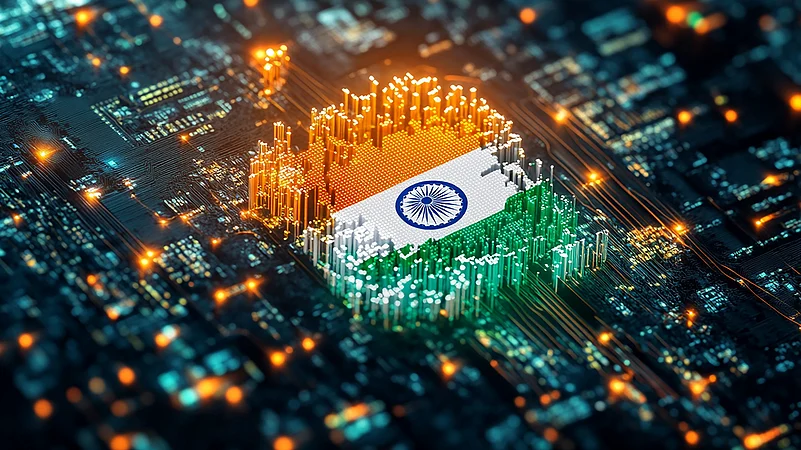As Washington lifts curbs on critical chip design software, India’s semiconductor dreams face a reality check.
In the semiconductor wars, design is everything. And this week, the U.S. quietly handed China a win.
Washington has reversed key export restrictions on chip design software—known in the industry as EDA (electronic design automation) tools—that are essential for building modern semiconductors.
The curbs had been in place since 2022, part of a sweeping U.S. effort to stall Beijing’s chip ambitions. Now, with geopolitical calculus shifting, that leash has loosened.
For China, it’s a green light to push harder on advanced chip design. For India? It’s a flashing red alert.
India has spent the last two years trying to get serious about semiconductors—wooing global giants, announcing fabrication subsidies, and greenlighting projects in Gujarat and Tamil Nadu. But here’s the uncomfortable truth: most of India’s focus is still stuck at 28nm technology. That’s miles away from the bleeding edge of 3nm and 2nm chips that power AI, defence systems, and next-gen smartphones.
Meanwhile, China—despite sanctions—is now back in the EDA game. Its foundries are still behind, but with restored access to American design software from companies like Synopsys and Cadence, its chip design pipeline just got a lot more potent. That means the country can prototype faster, optimise architectures smarter, and speed up its climb toward full-stack chip independence.
India doesn’t have that luxury. It has no domestic EDA tools, no real ecosystem for chip IP, and minimal design infrastructure. The global chip race isn’t just about fabs—it’s about owning the blueprint, controlling the stack, and scaling up fast. And right now, India is still sketching the plan.
The U.S. just shifted the playing field. China’s back in the design game. And India? It better pick up the pace.
If you want to see where things stand, scroll down. Our explainer breaks down India’s chip capabilities—what kinds of semiconductors it can realistically produce today, what all the jargon (like nanometres and wafer yields) actually means, and how far it has to go to catch up with the global big leagues.
In mid-2025, India is expected to hit a critical milestone: the rollout of its first fully domestically manufactured semiconductor chip. It’s a symbolic breakthrough—placing India in a small club of nations with full-stack chip fabrication capabilities, alongside the US, Taiwan, South Korea, Japan, and China. But symbolism alone won’t cut it.
The news is not insignificant because, although India has long excelled in chip design, it has until now depended entirely on foreign foundries for fabrication. But in the context of the global semiconductor race it is a relatively small step.
The release of the first indigenously fabricated chip, even if it uses older technology compared to today’s most advanced nodes, represents a breakthrough and could open the way to India’s strategic push towards semiconductor self-reliance, a critical goal for both national security and economic resilience. But that's not going to happen in a hurry.
India imports 85% of its semiconductors, making it vulnerable to global disruptions. With demand projected to reach $100 billion by 2030, building a local chip ecosystem is vital for national security, economic resilience, and digital autonomy. ‘Make in India’ chips will reduce dependency, boost innovation, and attract global investment.
"But what exactly is all this hoopla about?" What is a semiconductor? Why is fabrication such an elite capability, held by only a handful of nations? What does nm mean—the unit that measures chip technology? And what do India’s 28nm and 90nm chips actually do?
We break it all down in plain language.
Q1. What is nm?
nm stands for nanometre—a billionth of a metre. In semiconductor fabrication, it refers to the size of transistors and other components on a chip. Smaller nm values indicate more densely packed transistors.
Q2. What are 28nm and 90nm (the chips India can now fabricate)?
These refer to the process nodes used in chip fabrication. 90nm is used in older technologies—like industrial controllers and automotive systems. 28nm, while not cutting-edge, still powers a large share of devices like budget smartphones, routers, and set-top boxes.
Q3. What do the figures before nm mean?
They represent the scale of features on the chip. The smaller the number, the more transistors can be packed onto a chip, leading to better performance and efficiency.
Example: The iPhone 15 Pro uses a 3nm chip—fast, efficient, powerful. The original iPhone used a 90nm chip, which was larger, slower, and consumed more power.
Q4. Why is “lower” better?
Smaller nodes translate to faster processing, lower energy use, and improved heat management.
This benefits everything—from quicker apps on your phone, to safer electronics in your car, to more agile systems in defence.
Q5. In that context, what does India’s achievement mean—both in theory and application?
In theory, it confirms that India can now fabricate chips domestically, joining a domain long dominated by a few global players.
In application, it means India can now produce chips for essential sectors—automotive, industrial, telecom—without relying entirely on imports. At this level, India still can't fabricate chips for high-end AI servers or flagship phones, but it's a decisive entry point.
Q6. Realistically, how long will it take India to bridge the gap to cutting-edge nodes like 3nm?
It could take 10–15 years, depending on sustained investment, policy continuity, and talent development. Other countries took decades to get there.
Q7. What are the key challenges?
The road ahead involves creating advanced fabs and cleanrooms, nurturing specialised talent, securing capital, and building a robust domestic supply chain for materials and tools—all of which take time and coordination.
Q8. What can India do to shorten the timeline?
India can move faster by scaling up government incentives, forming deeper partnerships with global chipmakers, developing its talent pool through targeted skilling, and fast-tracking semiconductor parks with ready infrastructure.













